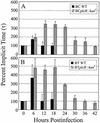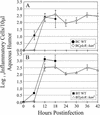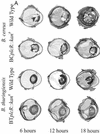Relationship of plcR-regulated factors to Bacillus endophthalmitis virulence
- PMID: 12761089
- PMCID: PMC155772
- DOI: 10.1128/IAI.71.6.3116-3124.2003
Relationship of plcR-regulated factors to Bacillus endophthalmitis virulence
Abstract
The explosive, destructive course of Bacillus endophthalmitis has been attributed to the production of toxins during infection. In this study we analyzed the contribution of toxins controlled by the global regulator plcR to the pathogenesis of experimental Bacillus endophthalmitis. Isogenic plcR-deficient mutants of Bacillus cereus and Bacillus thuringiensis were constructed by insertional inactivation of plcR by the kanamycin resistance cassette, aphA3. Rabbit eyes were injected intravitreally with approximately 100 CFU of wild-type B. cereus or B. thuringiensis or a plcR-deficient mutant. The evolution of endophthalmitis resulting from each plcR-deficient mutant was considerably slower than that caused by each wild-type strain. Retinal function was not eliminated until 42 h postinfection in rabbits with endophthalmitis caused by the plcR-deficient mutants, whereas wild-type infections resulted in a complete loss of retinal function within 18 h. The intraocular inflammatory cell influx and retinal destruction in plcR-deficient endophthalmitis approached the severity observed in wild-ype infections, but not until 36 h postinfection. Gross and histological examinations of eyes infected with plcR mutants demonstrated that the anterior and posterior segment changes were muted compared to the changes observed in eyes infected with the wild types. The loss of plcR-regulated factors significantly attenuated the severity of Bacillus endophthalmitis. The results therefore suggest that plcR may represent a target for which adjunct therapies could be designed for the prevention of blindness during Bacillus endophthalmitis.
Figures








References
-
- Agaisse, H., M. Gominet, O. A. Okstad, A. B. Kolsto, and D. Lereclus. 1999. PlcR is a pleiotropic regulator of extracellular virulence factor gene expression in Bacillus thuringiensis. Mol. Microbiol. 32:1043-1053. - PubMed
-
- Arvidson, S., and K. Tegmark. 2001. Regulation of virulence determinants in Staphylococcus aureus. Int. J. Med. Microbiol. 291:159-170. - PubMed
-
- Association for Research in Vision and Ophthalmology. 2002, posing date. Statement for the use of animals in ophthalmic and visual research. [Online.] Association for Research in Vision and Ophthalmology, Rockville, Md. http://www.arvo.org/AboutARVO/animalst.htm.
-
- Block, F., and M. Schwarz. 1998. The b-wave of the electroretinogram as an index of retinal ischemia. Gen. Pharmacol. 30:281-287. - PubMed
Publication types
MeSH terms
Substances
Grants and funding
LinkOut - more resources
Full Text Sources

